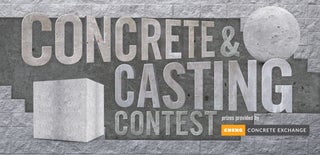Introduction: Non-Slip Pervious Concrete Stepping Stone
This Instructable is to create a stepping stone out of pervious concrete that has a personalized touch. Pervious concrete allows water to flow through it thus eliminating ponding on the surface that may be slick. The personalized patterned is created by using two different types of aggregate that are different sizes and/or color.
Supplies
- Portland cement
- aggregate (I use two different types to create a pattern: pea gravel and crushed limestone)
- water
- 2" x 4" x 8' stud
- 2' x 2' sheet of plywood
- 2' x 2' piece of plastic sheeting
- finishing nails
- 2-1/2" wood screws
Equipment
- 2 - 5 gallon buckets
- 2 - small containers (aprox. 1 gallon each)
- drill
- sander, grinder, or concrete polisher
- hammer
- scale
- hand saw, circular saw, or miter saw (recommended)
Step 1: Construct Form
I started by drawing the pattern on the plywood and then attached form around it. I created a T for Tennessee. The form is 16 inches by 16 inches and is made of 2"x4". Add trim around the bottom edge of the form to give the stepping stone a rounded edge. Create the form for the pattern out of cardboard, tape, and cups (for curves).
Step 2: Mix Pervious Concrete
Pervious concrete is made of Portland cement, aggregate, water, and sand (in small amounts). I used only Portland cement and aggregate. Measure out the quantity needed to fill the form using a scale. Assume that the aggregate will fill all of the space in the form. I used a Portland cement:aggregate ratio of 1:5 by weight and a ratio of 1:0.33 for aggregate:water by weight. Mix together until the aggregate has a layer of concrete paste on it but there is still space for water to move through the pores. Add water or Portland cement as needed. I created two different mixes. One made with pea gravel and a mix made with crushed limestone.
Step 3: Pack Form and Let Concrete Cure
Pack the pattern portion first. Compact the concrete 1 inch at a time with end of a 2"x4". After the first 2 inches, remove the pattern form and add the second pervious concrete type. Finish packing the concrete and then cover with plastic. Leave the concrete covered for approximately 7 days to cure.
Step 4: Expose Pattern in Aggregate
Remove plastic and disable form. Flip the stepping stone over to view the pattern. Expose the color of the two different types of aggregate by grinding the concrete paste from them. I used a wire brush attached to a drill for this step. Periodically wipe the surface off with a wet rag to keep the dust suppressed. Other grinding and polishing tools may be used to achieve the desired look.
Step 5: Test Infiltration and Use
If you made it to this step you're finished! Now go pour water through the concrete and find it a permanent home.

Participated in the
Concrete and Casting Contest











